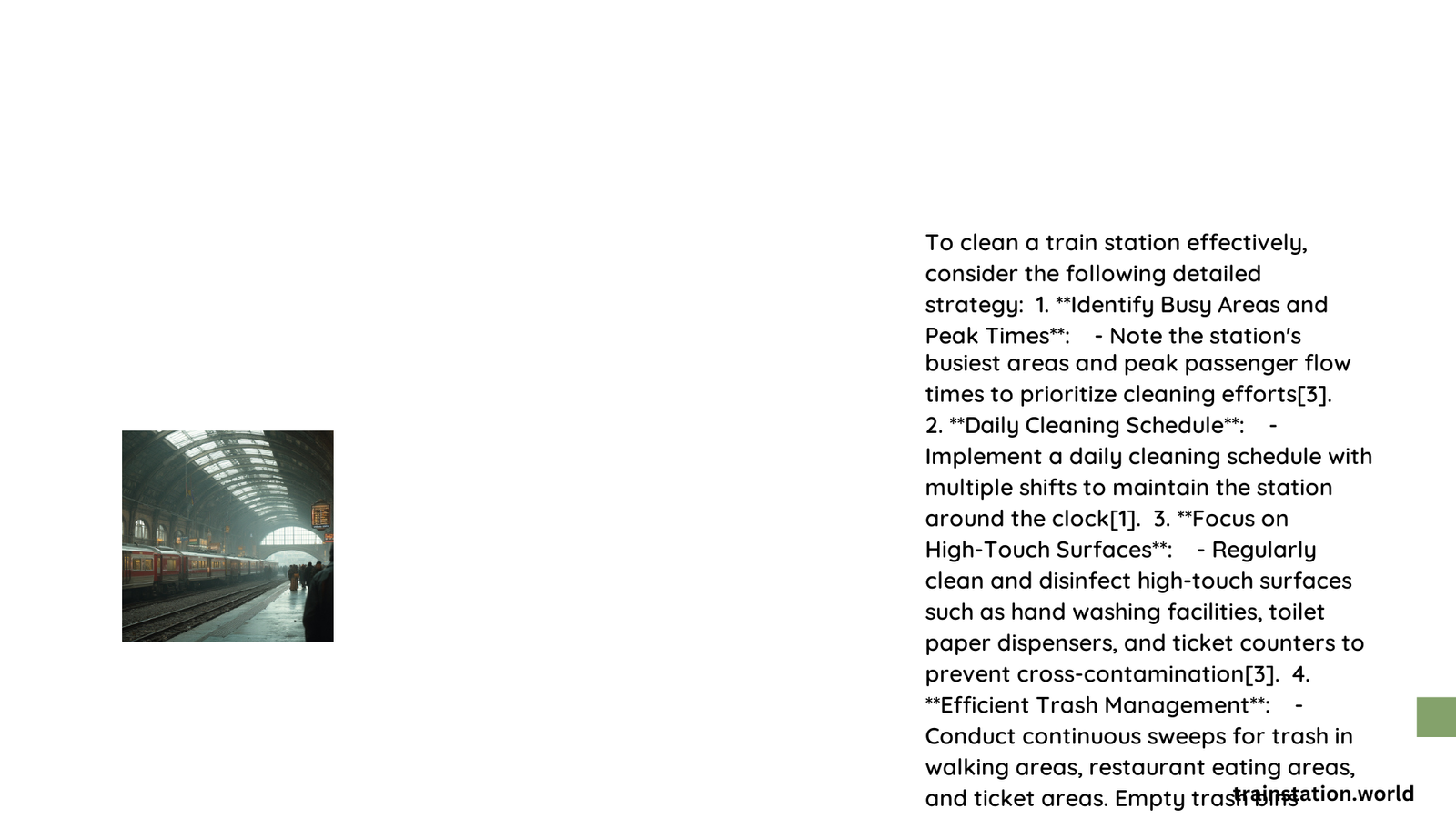Clean train stations are crucial for passenger safety, comfort, and overall transit experience. Maintaining cleanliness in these high-traffic areas requires rigorous protocols, frequent cleaning schedules, and specialized equipment. This comprehensive guide explores the best practices for keeping train stations clean, addressing challenges unique to these environments, and highlighting the importance of cleanliness in public transportation hubs.
What Are the Key Components of a Clean Train Station?
A clean train station encompasses several critical areas:
- Platforms
- Waiting areas
- Ticket counters
- Restrooms
- Escalators and elevators
- Food courts and retail spaces
Each of these areas requires specific cleaning approaches and schedules to maintain optimal hygiene standards.
How Often Should Train Stations Be Cleaned?

The frequency of cleaning in train stations depends on various factors:
- Passenger traffic
- Time of day
- Weather conditions
- Special events
Generally, high-touch surfaces should be cleaned multiple times per day, while deep cleaning may occur nightly or weekly. For example:
| Area | Cleaning Frequency |
|---|---|
| Restrooms | Every 2-4 hours |
| Platforms | 2-3 times daily |
| Waiting areas | Hourly during peak times |
| Escalators | Daily deep clean, hourly wipe-downs |
What Cleaning Products Are Most Effective for Train Stations?
Effective cleaning of train stations requires the use of appropriate cleaning agents:
- EPA-approved disinfectants
- Industrial-strength degreasers
- Specialized floor cleaners
- Eco-friendly, non-toxic products
It’s crucial to select products that are effective against a wide range of pathogens while being safe for use in public spaces.
How Can Technology Improve Train Station Cleanliness?
Modern technology plays a significant role in maintaining clean train stations:
- Automated cleaning robots
- UV-C disinfection systems
- IoT sensors for real-time cleanliness monitoring
- Digital cleaning schedules and task management systems
These technologies can enhance efficiency, ensure consistent cleaning standards, and provide data-driven insights for improvement.
What Are the Challenges in Maintaining a Clean Train Station?
Keeping train stations clean presents several unique challenges:
- High foot traffic
- 24/7 operations
- Diverse surfaces and materials
- Weather-related issues
- Vandalism and graffiti
Addressing these challenges requires a comprehensive approach that combines regular maintenance, strategic cleaning schedules, and durable materials.
How Does Cleanliness Impact Passenger Satisfaction?
A clean train station significantly influences passenger satisfaction:
- Improved perception of safety
- Enhanced overall travel experience
- Increased likelihood of repeat usage
- Positive word-of-mouth recommendations
Studies have shown that cleanliness ranks among the top factors affecting passenger satisfaction in public transportation.
What Are the Best Practices for Train Station Restroom Maintenance?
Maintaining clean restrooms in train stations is crucial:
- Frequent cleaning and restocking
- Use of touchless fixtures
- Proper ventilation
- Regular deep cleaning and sanitization
- Clear signage for reporting issues
Implementing these practices can significantly improve the overall cleanliness and user experience of train station restrooms.
How Can Passengers Contribute to Keeping Train Stations Clean?
Passenger involvement is key to maintaining clean train stations:
- Proper disposal of trash
- Reporting cleanliness issues
- Following hygiene guidelines
- Respecting no-eating or drinking zones
Educating passengers about their role in maintaining cleanliness can create a culture of shared responsibility.
What Are the Environmental Considerations in Train Station Cleaning?
Environmentally friendly cleaning practices are increasingly important:
- Use of eco-certified cleaning products
- Water conservation measures
- Energy-efficient cleaning equipment
- Proper waste management and recycling
Implementing green cleaning practices not only benefits the environment but can also improve air quality within the station.
How Does Weather Affect Train Station Cleanliness?
Weather conditions significantly impact train station cleanliness:
- Rain and snow tracking in dirt and moisture
- Increased leaf litter in autumn
- Sand and dust accumulation in dry seasons
Adapting cleaning strategies to seasonal changes is crucial for maintaining cleanliness year-round.
What Role Do Staff Training Programs Play in Maintaining Clean Train Stations?
Effective staff training is essential for maintaining clean train stations:
- Proper use of cleaning equipment and products
- Understanding of hygiene standards and protocols
- Customer service skills for addressing cleanliness concerns
- Safety procedures for handling hazardous materials
Regular training updates ensure that staff remain knowledgeable about the latest cleaning techniques and standards.
How Can Design Elements Contribute to a Cleaner Train Station?
Thoughtful design can significantly impact the cleanliness of train stations:
- Easy-to-clean surfaces and materials
- Adequate trash and recycling receptacles
- Proper drainage systems
- Anti-graffiti coatings on walls and surfaces
Incorporating these elements during station design or renovation can make ongoing maintenance more efficient and effective.
What Are the Health Benefits of a Clean Train Station?
Maintaining a clean train station offers numerous health benefits:
- Reduced spread of infectious diseases
- Improved air quality
- Decreased risk of slip-and-fall accidents
- Enhanced mental well-being of passengers
These health benefits contribute to a safer and more pleasant travel experience for all station users.
How Can Technology Be Used to Monitor Cleanliness in Train Stations?
Advanced monitoring technologies can enhance cleanliness management:
- Real-time occupancy sensors
- AI-powered cleanliness assessment cameras
- Digital feedback systems for passengers
- Automated maintenance scheduling software
These technologies provide valuable data for optimizing cleaning routines and addressing issues promptly.
In conclusion, maintaining a clean train station requires a multifaceted approach involving regular cleaning schedules, appropriate cleaning products, staff training, and passenger cooperation. By implementing best practices and leveraging technology, train stations can provide a hygienic, safe, and pleasant environment for travelers.
References:
1. Paragon Group
2. Ride RTA
3. Wanderu
4. Burgos Cleaning
